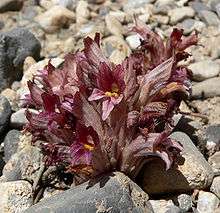Orobanche corymbosa
| Orobanche corymbosa | |
|---|---|
 | |
| Scientific classification | |
| Kingdom: | Plantae |
| (unranked): | Angiosperms |
| (unranked): | Eudicots |
| (unranked): | Asterids |
| Order: | Lamiales |
| Family: | Orobanchaceae |
| Genus: | Orobanche |
| Species: | O. corymbosa |
| Binomial name | |
| Orobanche corymbosa (Rydb.) Ferris | |
Orobanche corymbosa is a species of broomrape known by the common name flat-top broomrape. It is native to western North America[1] where it is a parasite growing attached to the roots of other plants, usually sagebrush (Artemisia tridentata). It produces a cluster of thick, glandular stems with enlarged bases and stout roots, the hairy stems pale whitish or yellowish, often purple-tinged, and up to 17 centimetres (6.7 in) tall. As a parasite taking its nutrients from a host plant, it lacks leaves and chlorophyll. The inflorescence is a wide array of a few tubular flowers. Each is 2 centimetres (0.79 in) or 3 centimetres (1.2 in) long, coated in glandular hairs, and dark-veined pink or purple in color.[2]
References
- ↑ "Flat-top broomrape". USDA. Plants Profile. Retrieved December 5, 2009.
- ↑ "Orobanche corymbosa". Jepson Manual Treatment. Berkeley, California: University of California. Retrieved December 5, 2009.
External links
 Media related to Orobanche corymbosa at Wikimedia Commons
Media related to Orobanche corymbosa at Wikimedia Commons- Photo gallery
This article is issued from
Wikipedia.
The text is licensed under Creative Commons - Attribution - Sharealike.
Additional terms may apply for the media files.
